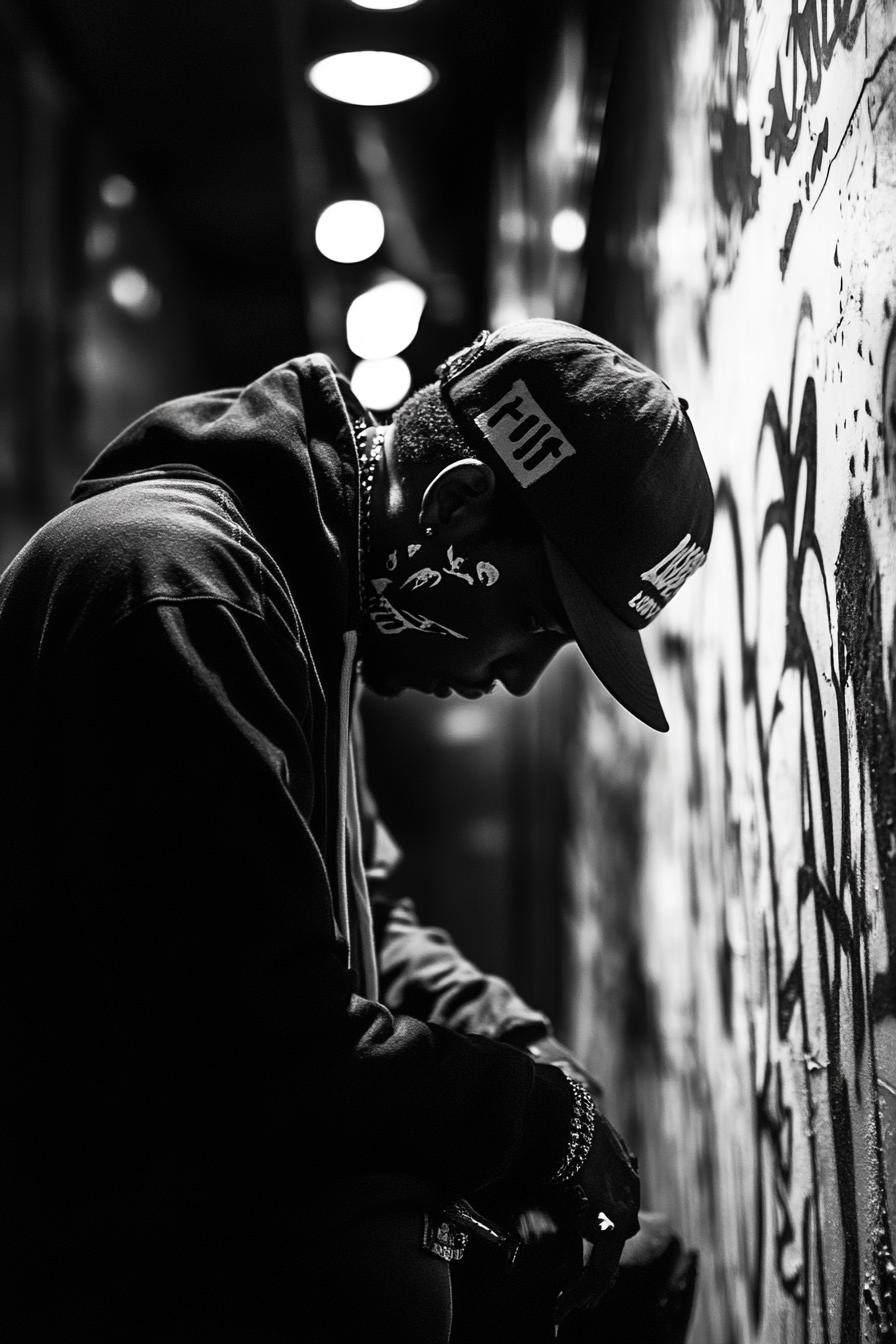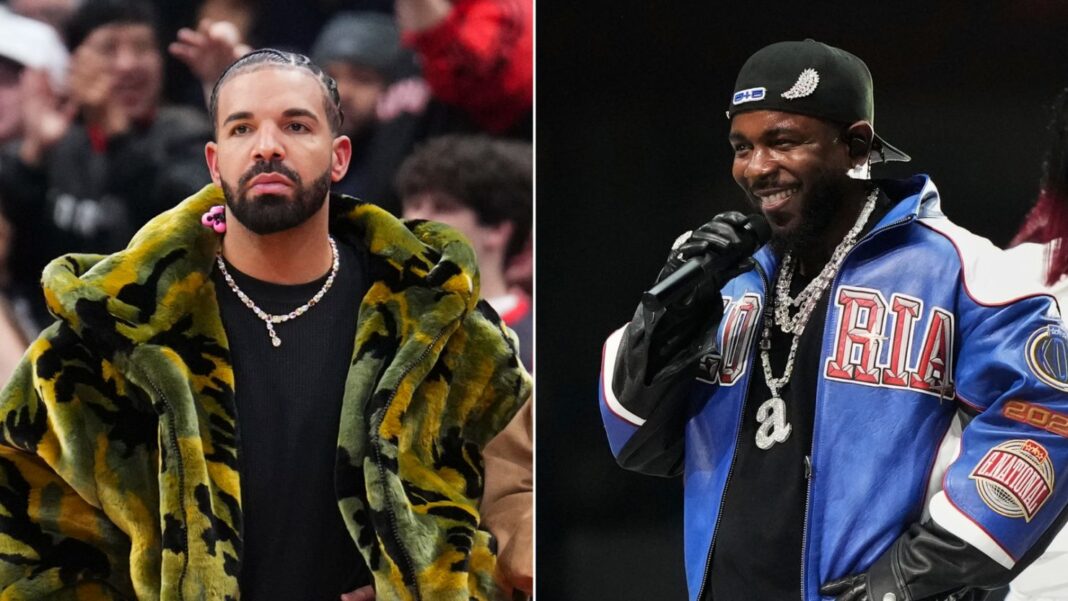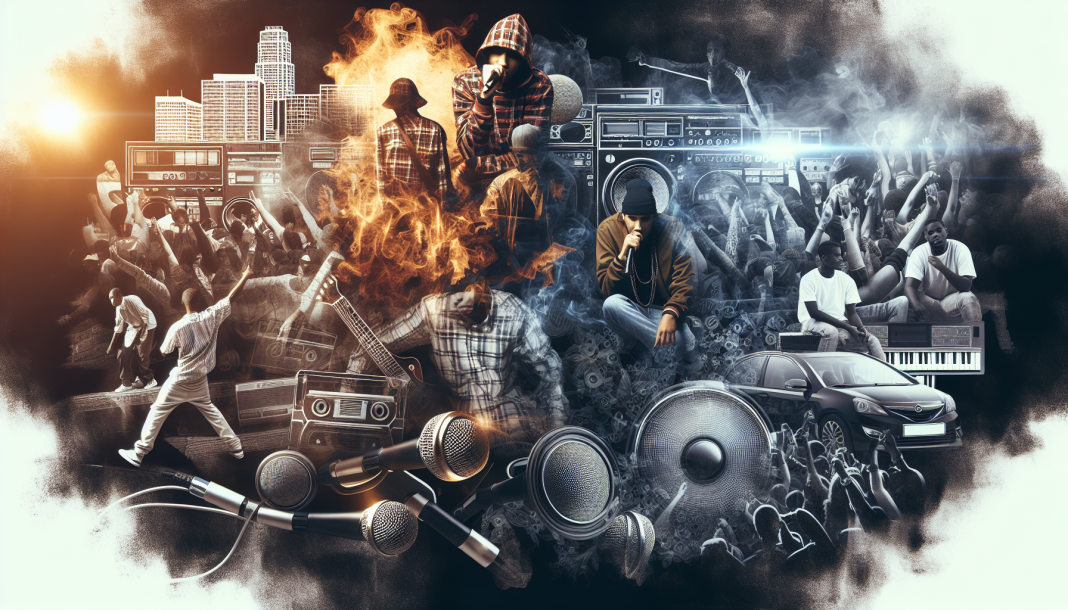The Evolution of Hip-Hop Feuds
Roots of Hip-Hop Rivalries
Hip-hop, as a music genre and cultural movement, has its roots deeply embedded in the streets of New York City during the 1970s. The competition among artists initially aimed at showcasing talent and lyrical prowess, giving rise to friendly rivalries. These rivalries were often based on geographical locations, with artists representing their respective neighborhoods or boroughs.
In the early days, hip-hop battles were predominantly hosted live at block parties and DJ events. These battles were characterized by lyrical improvisation and dance face-offs, which aimed to establish who had superior skill and style. The intensity of these early competitions laid the groundwork for more intense rivalries that would later emerge within the hip-hop community.
Transformation into ‘Beefs’ in Hip-Hop Culture
As hip-hop evolved through the 1980s and 1990s, rivalries began to transform into more contentious conflicts known as ‘beefs.’ These feuds were not just about showcasing talent but also involved personal attacks and public confrontations. The rise of mass media and the recording industry’s commercialization of hip-hop played significant roles in this transformation.
During the 1990s, the interplay between media coverage and hip-hop artists’ personas led to the infamous East Coast vs. West Coast rivalry. This period saw the intensification of feuds between artists, with highly publicized altercations and diss tracks becoming common.
One of the most notable feuds of this era was between The Notorious B.I.G. (Biggie) and Tupac Shakur (2Pac). Their conflict epitomized the volatile nature of hip-hop beefs, with both artists using their music to address personal grievances and accuse each other of various wrongdoings.
Beefs also began to have broader social and cultural implications. The lyrics and themes of conflict extended beyond music, reflecting the artists’ personal experiences and societal issues. These rivalries often highlighted deeper issues such as community pride, identity, and the struggle for respect and recognition within the industry.
The table below illustrates the shift from friendly rivalries to serious beefs over the decades:
| Decade | Type of Conflict | Characteristics |
|---|---|---|
| 1970s | Friendly Rivalries | Localized, lyrical battles, dance-offs |
| 1980s | Growing Tensions | Increasing competition, media attention |
| 1990s | Beefs | Public feuds, diss tracks, media escalation |
Understanding the roots and evolution of hip-hop feuds sheds light on how these conflicts have shaped the genre. They reflect not only personal rivalries but also broader cultural and societal dynamics. The transition from neighborhood competitions to highly publicized beefs has significantly impacted hip-hop culture and the music industry as a whole.
Iconic Feuds in Hip-Hop History
Hip-hop history is rich with iconic rivalries that have shaped the genre and left a lasting impact on the culture. Some of these ‘beefs’ have become legendary, defining moments in the evolution of hip-hop.
East Coast vs. West Coast Feud
The East Coast vs. West Coast feud is perhaps the most famous hip-hop rivalry. This conflict emerged in the early 1990s between artists and fans of the East Coast, primarily New York, and those of the West Coast, mainly Los Angeles. The feud was fueled by differences in rap styles, regional pride, and media sensationalism.
This rivalry intensified with direct confrontations and diss tracks exchanged between artists from both coasts. Notable figures in this feud included Sean “P. Diddy” Combs and Notorious B.I.G. from the East Coast, and Suge Knight and Tupac Shakur from the West Coast.
| East Coast | West Coast | Key Figures |
|---|---|---|
| New York-based | Los Angeles-based | P. Diddy, Notorious B.I.G., Tupac Shakur, Suge Knight |
| Rap style focused on lyricism | Rap style prioritized beats and flow |
Biggie vs. Tupac: The Legendary Battle
The feud between Biggie Smalls (The Notorious B.I.G.) and Tupac Shakur is one of hip-hop’s most tragic rivalries. Initially friends, their relationship soured over misunderstandings and public accusations, with Tupac believing Biggie and Puff Daddy were involved in a robbery that resulted in him being shot.
The tension between the two rappers escalated through songs and media appearances. Tupac’s track “Hit ‘Em Up” was a direct assault on Biggie, escalating the conflict further. Unfortunately, both artists were murdered within a year of each other, adding to the mythos surrounding their feud.
| Feud Details | Tupac Shakur | Notorious B.I.G. |
|---|---|---|
| Dates | Mid-1990s | Mid-1990s |
| Diss Tracks | “Hit ‘Em Up” | “Who Shot Ya?” |
| Outcome | Both artists tragically killed | Both artists tragically killed |
Nas vs. Jay-Z: A Clash of Titans
The clash between Nas and Jay-Z is another well-known hip-hop feud, marking a pivotal moment in the early 2000s. The rivalry began with subtle jabs in their lyrics but soon escalated into full-blown diss tracks. Jay-Z’s “Takeover” criticized Nas’s career and skill, leading Nas to respond with “Ether,” a track that has since become a verb for destroying someone in a rap battle.
Unlike the tragic end of the Biggie and Tupac feud, Nas and Jay-Z reconciled, performing together and acknowledging each other’s talents. This feud is often cited as a battle of lyrical prowess and has become a defining chapter in hip-hop history.
| Feud Details | Nas | Jay-Z |
|---|---|---|
| Dates | Early 2000s | Early 2000s |
| Diss Tracks | “Ether” | “Takeover” |
| Outcome | Reconciliation | Reconciliation |
These famous hip-hop feuds have not only shaped the careers of the involved artists but also influenced the trajectory of the genre. Through these rivalries, the raw emotions, lyrical dexterity, and cultural commentary that define hip-hop were vividly showcased.
Impact of Hip-Hop Feuds
Influence on Music and Lyrics
Hip-hop feuds have significantly shaped the music and lyrical content of the genre. Artists often channel their rivalries through their songs, resulting in some of the most memorable tracks in hip-hop history. These diss tracks are marked by sharp lyrics, clever wordplay, and direct confrontations aimed at opponents. The creativity involved in crafting these tracks has elevated the art of storytelling and lyrical prowess in hip-hop.
| Feud | Notable Diss Track | Main Artist |
|---|---|---|
| East Coast vs. West Coast | “Hit ‘Em Up” | Tupac Shakur |
| Nas vs. Jay-Z | “Ether” | Nas |
| Drake vs. Meek Mill | “Back to Back” | Drake |
Societal Repercussions and Violence
The societal impact of hip-hop feuds extends beyond the music, often leading to real-world consequences. Some of these disputes have escalated into physical confrontations and violence, negatively impacting communities and individuals involved. High-profile feuds have sometimes culminated in tragic outcomes, drawing attention to the darker side of hip-hop rivalries.
| Feud | Incident | Outcome |
|---|---|---|
| Biggie vs. Tupac | Multiple altercations | Both artists murdered |
| East Coast vs. West Coast | Various confrontations | Heightened regional tensions |
| Drake vs. Meek Mill | Verbal and online spats | No physical violence |
Power Dynamics in the Industry
Hip-hop feuds also highlight the power dynamics within the music industry. Rivalries often emerge from competition for dominance and recognition. These battles can shift the balance of power among artists, record labels, and media outlets, influencing commercial success and the cultural landscape. The drama surrounding these feuds keeps audiences engaged, affecting album sales, concert attendances, and media coverage.
| Feud | Power Struggle Aspect | Industry Impact |
|---|---|---|
| Nas vs. Jay-Z | Lyrical superiority | Boost in record sales |
| Nicki Minaj vs. Cardi B | Dominance in female rap | Media frenzy, increased visibility |
| Pusha T vs. Drake | Authenticity vs. commercial success | Fans divided, heightened interest |
Understanding the impact of famous hip-hop feuds provides insight into how these conflicts shape music, influence societal behavior, and shift power within the industry.
Women in Hip-Hop Feuds
Female Empowerment in Feuds
Female rappers have played a significant role in the landscape of hip-hop feuds, often using rivalries as a platform for empowerment. These feuds have showcased the talent, resilience, and lyrical prowess of women in an industry that is predominantly male-dominated. Through their confrontations, female artists have challenged stereotypes and broken barriers, asserting their presence and influence in hip-hop.
Feuding in hip-hop for women is not just about conflict; it’s also about proving their capabilities and earning respect. Lyrical battles between female rappers have often highlighted not only their skills but also their ability to address important issues such as gender inequality and empowerment.
Gender Dynamics and Double Standards
While male rappers often gain notoriety and respect from their feuds, female rap artists face a double standard. Their conflicts are frequently scrutinized more heavily, and they are often labeled as “catfights” or “dramatic” instead of being recognized for their competitively spirited nature.
Gender dynamics in hip-hop feuds reveal the inherent biases in how male and female rappers are perceived and judged. This double standard can be seen in the differences in media coverage, fan reactions, and the overall narrative around these feuds. Female rappers are often expected to maintain a level of decorum and are criticized more harshly if they engage in rivalries, unlike their male counterparts.
| Aspect | Male Rappers | Female Rappers |
|---|---|---|
| Media Coverage | Often glorified | Seen as overly dramatic |
| Public Perception | Viewed as competitive | Labeled as emotional or petty |
| Industry Impact | Earn respect and status | Scrutinized and criticized |
| Role in Feuds | Key players | Often sidelined or marginalized |
In essence, the role of women in hip-hop feuds serves as a powerful lens to examine larger societal issues, such as gender bias and the challenges women face in asserting their identities. Through their participation in these rivalries, female rappers continue to challenge norms, inspire change, and pave the way for future generations in the world of hip-hop.
Media’s Role in Hip-Hop Feuds
The media has played a significant role in amplifying and shaping hip-hop feuds. Through extensive coverage and sensationalism, media outlets have often escalated these rivalries, influencing public perception and fueling the intensity of the conflicts.
Escalation Through Media Coverage
Media coverage has historically escalated hip-hop feuds by focusing on the drama and conflict between artists. Headlines often sensationalize disagreements, turning them into full-blown “beefs” that capture public attention. Interviews, articles, and music video commentaries have all contributed to magnifying these disputes.
Media platforms, such as television, radio, and now social media, provide a stage for artists to voice their grievances and retaliations. The instantaneous nature of social media has further intensified the reach and speed at which these disputes spread.
| Medium | Impact on Feuds |
|---|---|
| Television | Reaches a broad audience, creating widespread awareness and interest. |
| Radio | Provides a platform for direct communication through interviews and music premieres. |
| Print Media | Offers in-depth articles and commentaries, adding layers to the narrative. |
| Social Media | Instantaneous sharing and viral potential escalate conflicts quickly. |
Influence on Public Perception
The media not only affects the progression of hip-hop feuds but also shapes how the public perceives these rivalries. By highlighting specific aspects of the conflict, media outlets can sway opinions, often portraying one artist as the victim and the other as the antagonist.
Public perception is further influenced by the narrative frameworks constructed by the media. These narratives can create a dichotomy between the feuding parties, often emphasizing themes of loyalty, betrayal, and competition. Fans, influenced by these stories, may take sides, further intensifying the feud.
This influence extends beyond just the fans, affecting how the general public views hip-hop culture as a whole. Media portrayal of these conflicts can lead to stereotypes and misconceptions about the genre and its artists.
| Influencing Factor | Result |
|---|---|
| Sensational Headlines | Attracts public interest and shapes initial opinions. |
| Artist Interviews | Provides personal perspectives that influence fan loyalty. |
| In-depth Articles | Adds context and depth, guiding public understanding and sentiment. |
| Social Media Posts | Real-time reactions and mobilization of fan bases. |
The media’s role in hip-hop feuds underscores its powerful impact on the progression and public perception of these legendary rivalries. By understanding this dynamic, one can better navigate the narratives presented and appreciate the complexities of famous hip-hop feuds.
Resolving Hip-Hop Feuds
Reconciliation and Truce
Hip-hop feuds, often rooted in lyrical battles, competitive spirit, and personal disagreements, can occasionally reach a point where reconciliation becomes possible. In several well-documented cases, artists have chosen to end their feuds, either through direct communication, public apologies, or symbolic gestures of peace.
| Feud | Reconciliation Method | Year of Truce |
|---|---|---|
| Nas vs. Jay-Z | Collaboration on stage | 2005 |
| Drake vs. Meek Mill | Public apologies and collaboration | 2018 |
| Fat Joe vs. 50 Cent | Public reconciliation | 2016 |
These truces not only bring closure to the involved parties but also offer a sense of relief to fans and communities affected by the tension. The reconciliation can take various forms, such as performing together, working on joint projects, or even simply acknowledging past mistakes and moving forward.
Legacy and Lessons Learned
Hip-hop feuds have left a lasting legacy on the genre, impacting the music, culture, and even the broader societal context. These intense rivalries have taught several important lessons:
- Creative Output: Feuds often lead to some of the most memorable tracks and albums, sparking creativity and pushing artists to elevate their lyrical and production skills.
- Cultural Reflection: These disputes mirror societal issues, such as racial tension, economic disparities, and personal struggles, bringing them to the forefront through music.
- Conflict Resolution: The eventual truce or resolution of feuds exemplifies the importance of dialogue, forgiveness, and understanding in any conflict scenario.
- Media Influence: The role of media in escalating and sometimes resolving conflicts highlights the power of narrative and public perception.
| Aspect | Positive Outcome | Negative Outcome |
|---|---|---|
| Creative Output | Memorable music | Potential for uninspired content post-feud |
| Cultural Reflection | Awareness of societal issues | Reinforcement of negative stereotypes |
| Conflict Resolution | Examples of reconciliation | Unresolved feuds leading to continued tension |
| Media Influence | Increased visibility | Sensationalism affecting real-life consequences |
Understanding the legacy and the lessons learned from famous hip-hop feuds offers valuable insights into not only the music industry but also into conflict resolution and cultural dynamics. It reflects how artists, fans, and communities interact and evolve through moments of tension and reconciliation.





